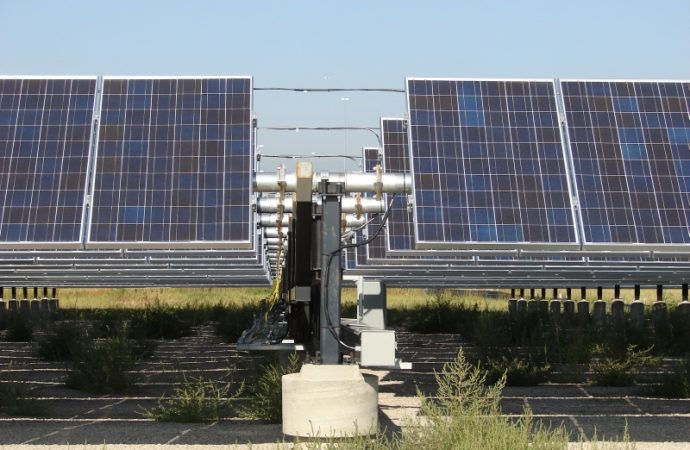The early supply-side sugar high induced by a raft of clean energy-related subsidies is starting to show signs of wearing off.
From electric vehicle makers to offshore wind developers, producers spurred along by the Biden administration’s ambitious green energy goals and lavish tax incentives have suddenly been forced to confront pesky market forces that have started to cool the once-rosy projections of green industrial policy proponents, namely tepid demand and rising capital costs. Now, the New York Times reports that those same problems are also beginning to give U.S. solar manufacturers pause.
According to the Times:
Dalton, Ga., was once known as the carpet capital of the country. Economic diversification meant branching out from wall-to-wall to hardwood flooring. Now, at Qcells, a solar panel company, robots patrol acres of shop floor where delicate solar cells are packaged, laminated and boxed into sophisticated panels — 6,000 a day — in a highly automated production line…
But rather than bragging, Qcells executives are raising an alarm. The Biden clean energy initiative is bringing plants like theirs on line at breakneck speed. And the rate of production — at home and abroad — has created the prospect of a glutted market that threatens to drive down the price of solar panels as the supply outpaces demand.
Mr. Biden’s political advantage in the clean energy economy could turn into a crippling liability, bordering on a nightmare: shutdowns and canceled construction plans rippling across the country, including in key 2024 states like Georgia, Arizona and Colorado.
“We should be very worried,” said Mike Carr, executive director of the Solar Energy Manufacturers for America Coalition, a trade association. “We are very worried.”
In other words, with public funds distorting typical considerations of profitability, solar producers have been pouring serious capital into domestic manufacturing facilities all across the country. Now that the subsidy-induced haze is starting to clear, concerns over real-world market conditions and the balance between supply and demand are beginning to emerge.
It’s a predicament not unlike the one currently facing down the U.S. auto industry.
Tantalized by the prospect of billions in taxpayer dollars promised by the federal Inflation Reduction Act, major automakers went on an investment frenzy as they sought to boost their electric vehicle offerings and build new production plants. Unfortunately, little attention was paid to consumers and their appetite for purchasing more expensive EVs. As a result, unsold EVs have been piling up on dealer lots, leading to major financial losses for manufacturers like Ford, GM, Rivian, and Lucid and a renewed sobriety in their investment plans.
And while the situation for U.S. solar firms does not yet appear to be as severe as it is for automakers, industry experts are starting to see plenty of cause for concern.
But Wood Mackenzie sees trouble. “Oversupply and intense competition will characterize the solar supply chain going forward, and is already driving cancellations of some expansion plans,” the firm wrote this month.
And while residential consumer demand has been strong, the biggest consumer — solar farm developers connected to electric utilities — have hit bottlenecks with transmission lines, transformers and land acquisition at a time of rising interest rates.
Throwing gobs of taxpayer money at private firms might be a good way of boosting the supply of a desired good in the short run, and it may win politicians plaudits for “job creation” in their home districts, but the strategy’s inefficiencies and market-distorting impacts become apparent over time. It does no one any good to produce clean energy technologies, be they electric vehicles or solar panel components, if there aren’t enough paying customers for them.
Meanwhile, for the demand that is there, China still produces a far higher quantity of the world’s solar components, at a far lower cost, than U.S. domestic manufacturers currently do.
But a dark cloud hangs over the solar industry’s rapid expansion, and it emanates from China. Wood Mackenzie, an independent energy research firm, recently wrote that the $130 billion that China has invested to maintain its control over solar panel components has created enough capacity to meet annual global demand until 2032, with a cost of production that is 65 percent cheaper than it is in the United States.
…
The United States imported a record number of foreign-made solar panels in July, August and September, S&P Global Market Intelligence said this month, up 55 percent from a year earlier and 30 percent from the three months before, the previous record.
And that has prompted its own push for even greater levels of government intervention in the energy economy, including new “tax preferences for U.S.-made components down to the very fine silicon that is formed into glass in solar cells.”
Such is the everlasting nature of green industrial policy and other attempts at central planning. Subsidies and other government handouts meant to solve one economic “problem” inevitably create new problems of their own, leading to ever more calls for public intervention to help fix what became broken by intervention in the first place.








